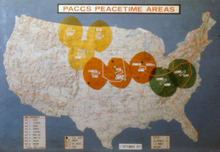 | ||
The Post Attack Command and Control System (PACCS) was a network of communication sites (both ground and airborne) for use before, during and after a nuclear attack on the United States. PACCS was designed to ensure that National Command Authority would retain sole, exclusive, and complete control over US nuclear weapons. Among other components, it included Strategic Air Command assets such as the Looking Glass aircraft and mission, and various hardened command and control facilities.
Contents
The belief by the Soviet Union in the reliability of PACCS was a crucial component of the US mutual assured destruction doctrine, ensuring a long term stalemate.
History
The Strategic Air Command headquarters staff, under the direction of General Thomas S. Power conducted the feasibility of placing a continuous command and control element in an airborne mode. The purpose of such a system would be to use the aircraft as a platform for specially installed communications equipment to insure delivery of command directives to SAC strike forces in the event ground-based headquarters were destroyed.
The original plan envisioned an aircraft, crew, and command and control team on 15-minute ground alert. This was later changed to a continuous airborne alert posture. The functions of this PACCS Airborne Command Post kept expanding until it became a true alternate command and control system, complete with force status monitoring, initiation or relay of launch/execution directives, a battle staff, communications to support an alternate CINCSAC, and limited capabilities to reconstitute and replan residual resources.
PACCS, in later variants, included an Airborne Launch Control System (ALCS) capability, which provided an alternate means for execution message delivery to missile combat crews and a back-up launch control center, forcing the Soviet Union to target each missile silo, rather than just the launch control centers to incapacitate the Minuteman force.
